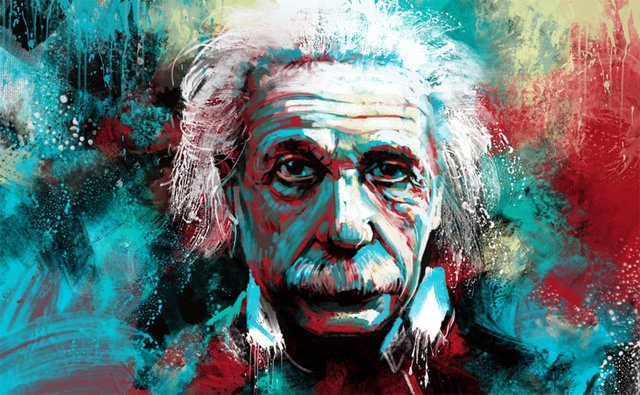At this point at the latest, our comparison with the ball game is no longer accurate. The speed of our ball with perhaps two meters per second is simply no longer comparable with the speed of light, which in a second about 300,000 kilometers through a passage of time to question to save the speed of light as a natural constant. That was indeed a stroke of genius. According to Einstein's theory, time, our reliable measure for all events, was as elastic as a rubber band. No matter how controversial his confusing views about time might be in the beginning, in the future it should prove to be true piece by piece.
During the mathematical elaboration of his theory, Albert Einstein also came across other physical quantities that had to change the faster their reference system moved. If his assumptions were correct, then not only had lengths to shorten, which Lorentz already recognized, but also the mass of the moving bodies had to increase. When the masses of bodies increase at high speeds, there had to be a relationship between mass and energy.
The result of these considerations was his famous formula E=MC².
That this formula explained the loss of masses in a nuclear fission or fusion and that the vanished masses would become free in the form of enormous energies, nobody suspected at that time.
But Einstein's theory was not yet complete. What was missing was gravity. If this force dominates the whole universe, then it also affects every reference system, then there was no reference system that moved in a straight line with constant speed according to the specifications of the special relativity theory. Because when gravity acts on a mass, it is accelerated. So how could accelerated movements be incorporated into the principle of relativity?
Albert Einstein owed the largest case of his life to an accident in his neighborhood. As he later writes: "While working on a house roof, a painter crashes and falls into the deep. While falling," he later reports, "he hadn't felt any weight. So if, during a free fall in the gravitational field of the earth, all things behave as if the gravitational field did not exist at all, as if one were moving weightlessly in a force-free space, then perhaps gravitation was not an independent force at all. Perhaps it was only a geometric property of space?".
The thought had far-reaching consequences. On the one hand, he conclusively explained Galileo's observation of why all things fall equally fast in a vacuum, no matter how heavy they are, on the other hand, how could one imagine a space in which gravitation was hidden as a geometric property?

 Part 4
Part 4 

 Part 6
Part 6 


@oendertuerk:-) I admire the use of navigation and layout! resteem ..
Downvoting a post can decrease pending rewards and make it less visible. Common reasons:
Submit
ty @sems42
Downvoting a post can decrease pending rewards and make it less visible. Common reasons:
Submit
Okay, I had to read it twice. Anyway, search for a video of an experiment dropping a feather and bowling bowl being dropped in vacuum. Both hit the floor at the same time. Include that video in your article. Your readers will see it for themselves. 😊
Posted using Partiko Android
Downvoting a post can decrease pending rewards and make it less visible. Common reasons:
Submit
good idea @oivas, ty :)
Downvoting a post can decrease pending rewards and make it less visible. Common reasons:
Submit
Here it is:
It's a BBC documentary showing the effect of gravity in vacuum.
Posted using Partiko Android
Downvoting a post can decrease pending rewards and make it less visible. Common reasons:
Submit
really cool! ty @oivas! :)
Downvoting a post can decrease pending rewards and make it less visible. Common reasons:
Submit
You are welcome. 😊
Posted using Partiko Android
Downvoting a post can decrease pending rewards and make it less visible. Common reasons:
Submit
I missed you there, could you explain me a bit what you mean with the assertion that gravity is not an independent force? Let's recap a bit, gravity sort off accounts for the effect that a massive object has into it's surrounding space, is it not? Then, gravity expresses itself as how much can a certain mass bend the space in it's vicinity... but then, the mass of an object has to increase the fastest it moves, then as an object moves faster it also bends more the space surrounding him?
Downvoting a post can decrease pending rewards and make it less visible. Common reasons:
Submit
Right, it is not independent and it depends on the space and the object how the gravitation behaves. the smaller the space in which an object is located, the more or less gravity affects it, of course it also depends on the size and mass of the object. If we have an unimaginable big/wide open space and only one football, then this football will not really bend the space. But if the space is as big as the loading area of a pickup, then the graviation/gravity of the football will bend the space on the loading area of the pickup more clearly.
Downvoting a post can decrease pending rewards and make it less visible. Common reasons:
Submit
Got it 😊 Thank you for clarifying it.
Downvoting a post can decrease pending rewards and make it less visible. Common reasons:
Submit
Hi, @oendertuerk!
You just got a 1.35% upvote from SteemPlus!
To get higher upvotes, earn more SteemPlus Points (SPP). On your Steemit wallet, check your SPP balance and click on "How to earn SPP?" to find out all the ways to earn.
If you're not using SteemPlus yet, please check our last posts in here to see the many ways in which SteemPlus can improve your Steem experience on Steemit and Busy.
Downvoting a post can decrease pending rewards and make it less visible. Common reasons:
Submit
Congratulations @oendertuerk!
Your post was mentioned in the Steem Hit Parade in the following category:
Downvoting a post can decrease pending rewards and make it less visible. Common reasons:
Submit
Hi @oendertuerk!
Your post was upvoted by @steem-ua, new Steem dApp, using UserAuthority for algorithmic post curation!
Your UA account score is currently 4.913 which ranks you at #1211 across all Steem accounts.
Your rank has not changed in the last three days.
In our last Algorithmic Curation Round, consisting of 154 contributions, your post is ranked at #23.
Evaluation of your UA score:
Feel free to join our @steem-ua Discord server
Downvoting a post can decrease pending rewards and make it less visible. Common reasons:
Submit